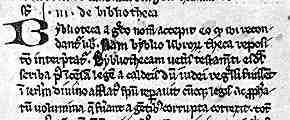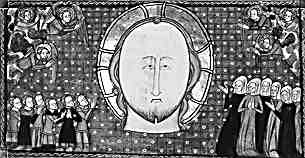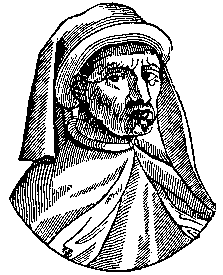






If you are looking at this page without frames, there is more information about medieval writing to be found by going to the home page (framed) or the site map (no frames).
| Compendia of Knowledge | ||||
| The medieval tradition of literate knowledge was cumulative, with a constant referring back to authoritative texts which formed the core of all written wisdom. A genre which typifies this process was what is often called the medieval encyclopedia, although it was not an encyclopedia in the sense that we use the term today. Like a modern encyclopedia, it did aspire to containing a summary of knowledge of all things about the world. However, it was not organised alphabetically or with indexes for random access of information, but as a structured text. The information in it was not expressed as dry, factual scientific data, but embedded in moral philosophy and allegory. | ||||
| A brief description of the major works of this genre is available in Twomey 1988. English translations of the chapter headings of several of the major works of this genre can be found on the Medieval Learning website, giving an idea of how the material in these works was organised. | ||||
| The great-granddaddy and prototype of the genre was Etymologiae, a 12 volume treatise written in the early 7th century by a Spanish monk, Isidore of Seville, a gentleman who clearly did not have enought to do with his time. He must have been regularly excused from choir duties, as he wrote other works as well, including a smaller encyclopedia. | ||||
 |
||||
| A litle grab from an 8th century copy of Etymologiae, originating from the monastery of Bobbio and produced in an early Italian minuscule script (Milan, Biblioteca Ambrosiana, L.99, parte superiore, p.35). (From Steffens 1929) | ||||
| Columbia University displays a page from a 9th century German copy of Isidore's Etymologiae. | ||||
| This work of Isidore spread rapidly around the monasteries of Europe, despite the massive task of transcription required. It also fed into the numerous encyclopedic works which followed it in later centuries, and was itself transcribed over many centuries. | ||||
 |
A segment from a 14th century copy of Etymologiae (Bern, Stadtbibliothek, Ms 129, f.34) written in a Gothic book hand. (From Steffens 1929) | |||
| The content of this huge work comprised, in the following order: grammar, rhetoric and dialectic, mathematics, medicine, scripture and liturgy, God and the angels, the church, languages, men, the animal and mineral worlds and the works of man. The work places observations of the natural world, derived largely from the Classical authors rather than from looking at it, into a context of scholarship and Christian thought. The angels were as much a part of the natural world as visible things. |  |
|||
| The fallen angels as depicted in a 15th century stained glass window in the church of St Michael Spurriergate, York. | ||||
| Isidore of Seville is regarded by many today as the patron saint of the Internet. It may even become official. He established a web of linked knowledge that survived and grew throughout the middle ages, but the process of logging on and downloading was just a little more laborious in those days. | ||||
| A Latin transcript of Isidore's Etymologiae can be found on the web at LacusCurtius: Isidore of Seville. | ||||
| In the early 9th century Rabanus Maurus expanded on the work of Isidore in his giant compilation De Rerum Naturis, also called De Universo. He added various kinds of allegorical and interpretative material to that provided by Isidore. His was also the first work to use an organising principle that was used in various later medieval encyclopedias, treating natural subjects in the order in which they appeared in the six days of creation, as written in Genesis. | ||||
 |
||||
| A series of stained glass panels representing the first days of creation high up in the 15th century east window of York Minster. | ||||
| The Rabanus Maurus. De rerum naturis website has a complete transcription, bibliography and list of manuscript copies of this work. | ||||
| By the 15th century, when manuscript book production was being overtaken by the work of the printing press, there were around 20 different encyclopedic compilations in use. Some of these, such as the 13th century Liber de Natura Rerum of Thomas of Cantimpré, the De Proprietatibus Rerum of Bartholomeus Anglicus or the Speculum Maius of Vincent of Beauvais were enormous compilations. The 13th century seems to have been an era of thinking big. Other works were of more modest scale, dealing with a subset of topics. Such works were written by Isidore himself and by medieval authors perhaps better known for certain other works, such as Bede or Hildegard of Bingen among others. |
 |
|||
| A medieval depiction of the sun and stars, from a 15th century stained glass window in the church of All Saints, North Street, York. | ||||
| A full digital facsimile of a copy of De Proprietatibus Rerum is dispalyed by the University of Victoria, Canada. Commentary and transcriptions are indicated as forthcoming. | ||||
| While many of the copies of these works were dense accumulations of words, words, words, there are a significant number of illustrated volumes extant, which in some cases demonstrate the difficulties of expressing visually some of the concepts discussed. | ||||
 |
Illustration from a 14th century compilation, Omne Bonum (British Library, Royal 6 E VI, f.16b), by permission of the British Library. | |||
| It is to be hoped that the exposition on the Beatific Vision in the text is more inspiring than the flying pie plate face in the image. Some things are better left in words. | ||||
| While the genre started off in the literate Latin tradition of ecclesiastical scholarship, it escaped into the vernacular. The first work composed in the vernacular was reportedly the 13th century Image du Monde of Gossuin of Metz, written in the Lorraine dialect of French. Works written originally in Latin were translated into various vernaculars in the middle ages and produced in manuscript copies in this form. The exceedingly popular and influential Bartholomeus Anglicus was translated into English, French, Provençal, Italian, Spanish, Dutch and German. Thomas of Cantimpré appeared in manuscript versions in French, German and Dutch. | ||||
| The Creating French Culture exhibition displays a leaf from the Image du Monde of Gossuin of Metz (Bibliothèque Nationale, Fr. 574). | ||||
 |
This class of works survived the era of manuscript book production. England's first printer, Caxton, produced an English language version of Gossuin of Metz, the Mirrour of the World in 1481. Bartholomeus Anglicus was produced in printed editions long after the end of the middle ages. | |||
| Caxton | ||||
| The way that these books were complied, structured and organised sheds some light on the medieval conception of literate knowledge. In many ways they represent the quintessential nature of medieval literate culture. | ||||
|
|
||||
|
If you are looking at this page without frames, there is more information about medieval writing to be found by going to the home page (framed) or the site map (no frames). |
||||